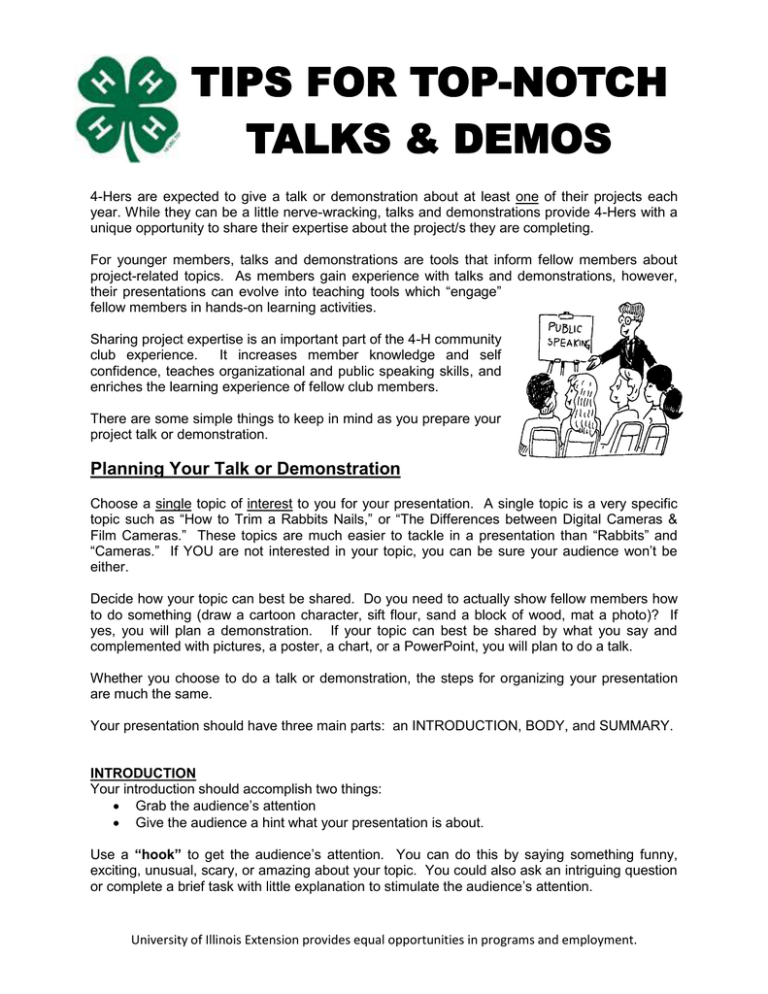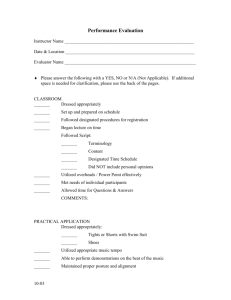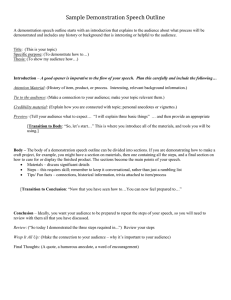/bdo/downloads/21553.doc
advertisement

4-Hers are expected to give a talk or demonstration about at least one of their projects each year. While they can be a little nerve-wracking, talks and demonstrations provide 4-Hers with a unique opportunity to share their expertise about the project/s they are completing. For younger members, talks and demonstrations are tools that inform fellow members about project-related topics. As members gain experience with talks and demonstrations, however, their presentations can evolve into teaching tools which “engage” fellow members in hands-on learning activities. Sharing project expertise is an important part of the 4-H community club experience. It increases member knowledge and self confidence, teaches organizational and public speaking skills, and enriches the learning experience of fellow club members. There are some simple things to keep in mind as you prepare your project talk or demonstration. Planning Your Talk or Demonstration Choose a single topic of interest to you for your presentation. A single topic is a very specific topic such as “How to Trim a Rabbits Nails,” or “The Differences between Digital Cameras & Film Cameras.” These topics are much easier to tackle in a presentation than “Rabbits” and “Cameras.” If YOU are not interested in your topic, you can be sure your audience won’t be either. Decide how your topic can best be shared. Do you need to actually show fellow members how to do something (draw a cartoon character, sift flour, sand a block of wood, mat a photo)? If yes, you will plan a demonstration. If your topic can best be shared by what you say and complemented with pictures, a poster, a chart, or a PowerPoint, you will plan to do a talk. Whether you choose to do a talk or demonstration, the steps for organizing your presentation are much the same. Your presentation should have three main parts: an INTRODUCTION, BODY, and SUMMARY. INTRODUCTION Your introduction should accomplish two things: Grab the audience’s attention Give the audience a hint what your presentation is about. Use a “hook” to get the audience’s attention. You can do this by saying something funny, exciting, unusual, scary, or amazing about your topic. You could also ask an intriguing question or complete a brief task with little explanation to stimulate the audience’s attention. University of Illinois Extension provides equal opportunities in programs and employment. Set the stage for your presentation by following the hook with details such as: your name, the number of years of experience you have in the project area you are presenting about, your presentation title, and how you became interested in the topic. BODY The body of your presentation should include all the interesting stuff you know about your topic. It is all of the different, neat things you want to tell (and/or show) people about your topic. People can only remember 3-5 main points or steps, so narrow your presentation down to that. SUMMARY Finish your presentation as neatly as you began by saying something interesting, scary, or funny about your topic. Tell a short, personal story that goes along with everything you’ve said, review the main points you covered during the middle, or recite a quote from a famous person. When you are done with your presentation, ask the audience if there are any questions. Answer the questions you can. If you don’t know an answer to a question, simply say that you don’t know. Don’t make up answers. You are an expert in training. You aren’t expected to know everything there is to know about your topic. TIPS FOR TALKS & DEMOS Practice your presentation before you do it for an audience. Try to keep your presentation between 3 and 5 minutes long. Don’t read your presentation to the audience. Refer to notes if you need to, but strive to be so comfortable with your topic that you are not dependent on them. Presentations that are completely read are usually very boring to the audience. Take a couple of deep breaths before you start. Stand up tall and smile! Use simple language and talk directly to the audience in a friendly conversational manner. Talk clearly and use expression in your voice! If you sound interested in your topic, your audience will be interested in finding out why! Make eye contact with the audience. If you are demonstrating something, keep your work space clean and neat. Make sure the audience can see what you are doing. If you are using a poster, pictures, props, etc., don’t display them until you are ready to talk about them. They are distracting to the audience. MEASURE YOUR SUCCESS After your presentation, ask yourself these questions so that your presentation is as good as, or even better than, this one! Did I get the audience so interested in my topic they might look into it more on their own? How do I know this? Was my presentation so clear that even the members who knew nothing about my topic beforehand could follow along? What did I learn from doing this presentation?


